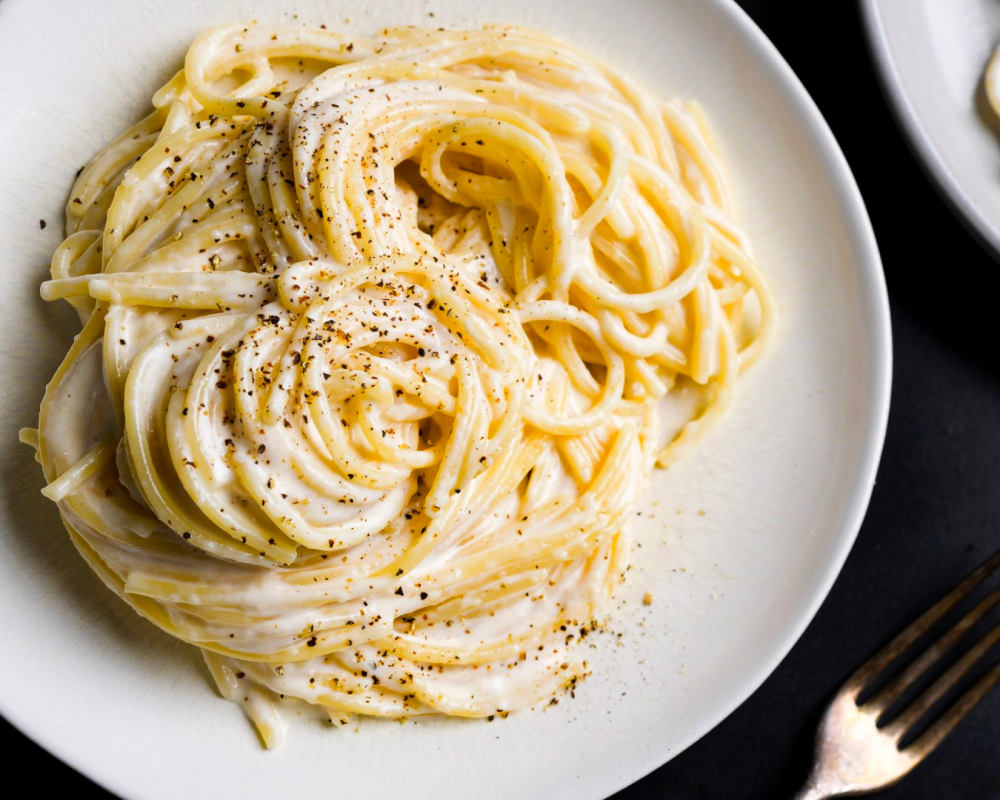I love parm. I’ll wait as long as humanly possible to say “when” at a restaurant and don’t hold back when grating it in the privacy of my own home. But even I was skeptical of creating a cream sauce with just parm to rely on. And it wasn’t for lack of flavor—I always trust the savory, nuttiness of really good Parmesan—however, I don’t always find that it combines smoothly into a sauce without becoming congealed. In fact, I rarely find that to be the case. Not so in this dish, claimed Lynn Clark. The alleged trick in this recipe? Lemon juice.
Step 1: Get the Best of the Best
When a dish has very few ingredients, the key to success is quality. Real Parmigiano-Reggiano imported from Italy is wildly different in flavor and texture to what you’ll find domestically, so that was first on the list for this recipe. To really do this right, I decided to head to Eataly. Don’t fret if you don’t have access to an Italian grocery though, your local Whole Foods should still have imported parm.
Step 2: Simmer the Cream
Over medium heat, I added two-and-a-half cups of heavy cream to a pot to start simmering. Two bay leaves and a good hunk of parmesan rind also got cozy. Occasionally stirring every few minutes to keep things moving, I let the sauce reduce down to about two cups—around 15 minutes. Once reduced, I removed the bay leaves and rind from the pot.
Step 3: Boil Your Pasta
While the sauce simmered, I salted my pasta water and got that going on the stove. Opting for bucatini, I cooked my noodles according to the package. Typically I like to undercook my pasta by a minute and let it finish in the sauce, but Clark specifically noted to avoid doing this with a cream-based sauce, as it can over-reduce the cream. Before draining the noodles, I reserved about half a cup of pasta water.
Step 4: Mix the Sauce
After my sauce had reduced to about two cups, I took the pot off the heat. It was time for the secret weapon: lemon juice. Turns out, the acidity of the juice acts as a thickening agent, which reacts with the proteins in the dairy to increase the viscosity. It’s a similar concept to adding vinegar to milk to make buttermilk, said Clark. Once combined, it was time for parm—18-month DOP Parmigiano Reggiano Cheese to be exact. I whisked all three cups in by the handful until shockingly smooth, finishing the mixture with a hit of black pepper. I kept expecting the mixture to get clumpy or hard to stir, yet every added handful only contributed to a creamier result.
Step 5: Combine and Plate
Once ready, I added the noodles and sauce to the same pot, stirring vigorously until everything was well combined. A bit of pasta water helped create glossy, thick sauce that clung to every strand of bucatini. Plate and serve.
This dish really blew my mind, especially from a food science perspective. Just a few tablespoons of lemon juice was all it took to dramatically impact the viscosity of the sauce. I was fully anticipating a broken mixture by the end of cooking, but to my delight, everything stayed well combined and luxuriously rich. I was also very impressed with the amount of flavor the bay leaves and parm rind imparted, leaving notes of salt, umami and an earthy-sweetness (almost pleasantly like nutmeg) that complemented the richness of the cream. For so few ingredients in such a short amount of time, Pasta with Parmesan Cream really outdid itself.
Join the conversation on Facebook, Instagram, TikTok and Pinterest.
And if you're looking for more Milk Street, check out our livestream cooking classes with our favorite chefs, home cooks and friends for global recipes, cooking methods and more.




